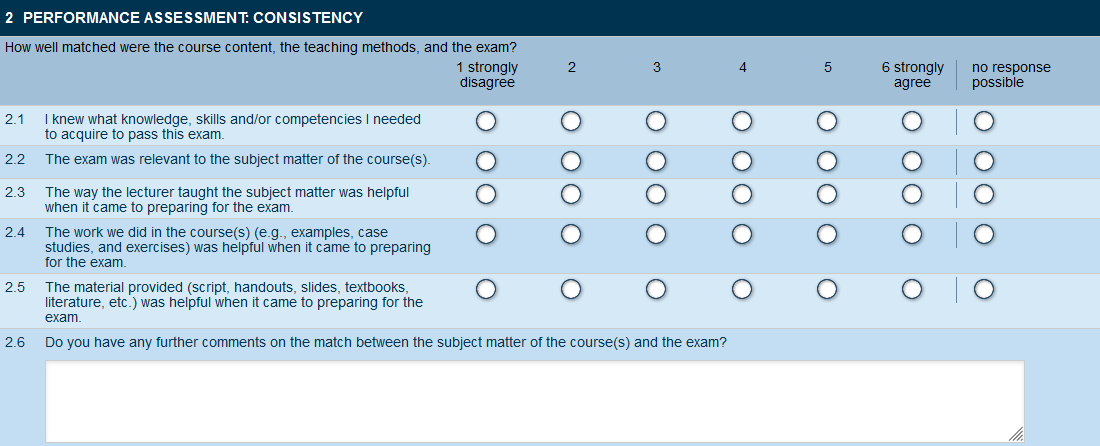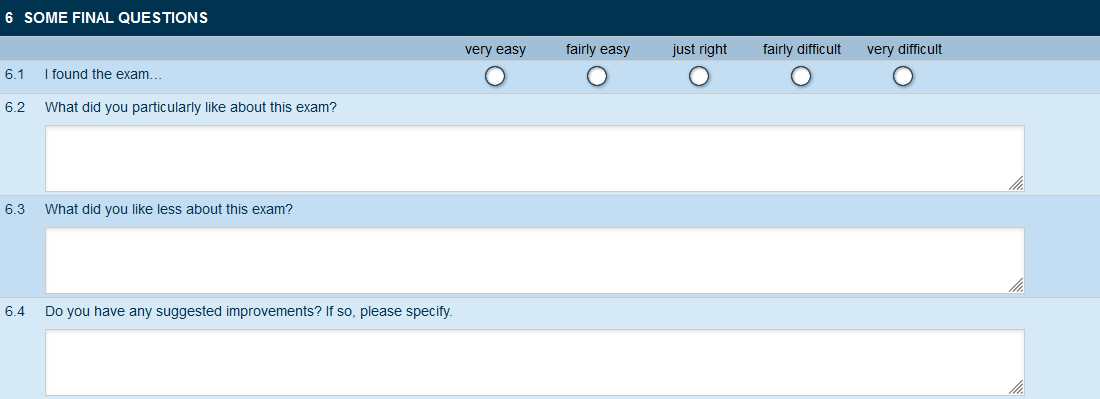Evaluations of performance assessments
The evaluation of performance assessment (evaluation of an exam) is carried out by means of standardised student surveys. The surveys are set up by the Teaching Evaluation Office and conducted in the central evaluation system evasys.

Usage of evaluations of performance assessments
The standardized questionnaire is suitable for evaluation of oral or written performance assessments that are directly related to a course and have at least 5 participants. Alternatively, faculties can use their own evaluation methods (e.g. focus group discussions), particularly for examinations with a small number of participants and for assessment formats that are not written or oral examinations.
In addition, lecturers are encouraged to use online-based tools as well as courses and counselling from the Learning and Development department to support their exam preparation.
Regular
The conceptual framework stipulates that 50% of all performance assessments are evaluated regularly (at least every 3 years). The faculties plan the evaluations accordingly, i.e. they select the performance assessments to be evaluated on a compulsory basis, taking into account their specific regulations.
Voluntary
Lecturers can have their performance assessments evaluated on a voluntary basis.

Purpose of evaluations of performance assessments
Performance assessments (examinations) play a central role in everyday teaching and learning at universities by steering teaching and guiding the learning behaviour of students. For this reason, the evaluation of performance assessments is of central importance for the organisation and developmentof of teaching.
The evaliuation provide lecturers and the faculty examination boards with data-based information on what can be improved in the performance assessments - and also in the courses (improvement orientation). The evaluation also serves to provide accountability to legislators and the public.
More information on the evaluation purposes is to find here.

Timing of evaluations of performance assessments
Default evaluation date: After the performance assessment has been completed (usually at 8pm on the day of the examination), from the 12th week of the semester.
Unless otherwise agreed, the surveys are conducted before the grades are announced. The evaluation results are only sent to the lecturers after the grades have been awarded. Particular attention is paid to compliance with data protection.

Content, method, languages
CONTENT
The standardized questionnaire for the evaluation of performance assessments (oral and written exams) is based on the Good Teaching Model and covers the following dimensions:
- constructive alignment (How well matched were the course content, the teaching methods and the exam?) (questions 2.1-2.5),
- the suitability of the form of the exam (question 3.1),
- the students' exam preparation, and learning success (questions 4.1-4.2).
- the framework conditions (questions 5.1-5.2)
- the perceived difficulty of the exam (question 6.1).
The "fairness" of an exam or grade are outside the scope of this evaluation.
The following questionnaire has been used since the spring semester 2023:







METHOD
Evaluations of performance assessments by means of the standard questionnaire are conducted online using the individual TAN-links sent directly to the students' emails.
LANGUAGES
The questionnaire is trilingual in German, English and French.

Procedure for evaluations of performance assessments
1. Registration
The registration of an evaluation usually takes place by the 10th week of the semester in KSL (see registration deadlines). In most cases, registration is carried out by a central office of the institute.
The following information must be available to register an evaluation of the performance assessment in the KSL:
- Exam date(s)
- Registration and deregistration deadlines for the exam
Evaluations of several examination dates are possible, but it is recommended that only one date per performance assessment be registered for evaluation.
Participant lists with at least 5 students must be available on the relevant examination date at the latest. They can also be added to KSL at a later date, but no later than 1 day before the assessment. Exam evaluations with fewer than 5 registrations are not set up in the evaluation system.
2. Preparation of surveys
Registered evaluations are transferred to the evasys evaluation system the night before the examination date and the surveys are then set up.
3. Information
Lecturers receive an automatic email message about the start of the survey as soon as the students receive the link to the survey.
The Teaching Evaluation Office does not inform lecturers in advance that an evaluation is planned.
4. Data collection
Students receive an email with the access link to the questionnaire at 8:00 pm on the day of the performance assessment.
The surveys remain open for 24 hours (oral assessments) or 4 days (written assessments and all other types) and are closed automatically. For surveys that last 4 days, a reminder will be sent after 2 days to those students who have not yet completed the survey.
5. Announcement of grades
Once the survey has been closed, the lecturer or a designated person can enter the grades in the KSL and forward them to the Dean's Office for approval.
Lecturers are free to set the grades earlier, but they should not yet be announced to the students (unless otherwise agreed or in exceptional cases - e.g. if exchange students need their grade earlier).
The lecturers then confirm to the Teaching Evaluation Office that the grades have been entered.
6. Validation
After the Teaching Evaluation Office has received confirmation that the grades have been entered, it checks the number of valid responses in order to preserve the anonymity of the students.
7. Report
If the response rate is sufficient (at least 5 valid responses), the report is sent to the lecturers. If the response rate is too low, the report will not be generated.
If there is no confirmation of the grade announcement, the reports are only sent to the lecturers after the deadlines individually agreed with the faculties (e.g. 6 weeks after the last examination).
8. Sharing results
It is recommended to share the evaluation results and the insights gained from them with the students (e.g. via ILIAS or by e-mail).
9. Adjustments
If necessary, the lecturers adjust their didactic concept of the course and/or of the performance assessment.
10. Follow up
The faculty's examination board analyse the results, draws up recommendations and takes appropriate measures.
The results can also be used for the evaluations of study programmes.
